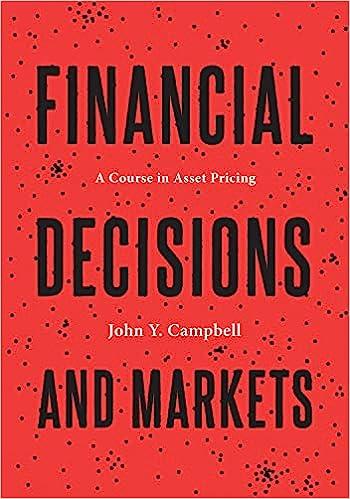Consider a frictionless one-period economy with multiple risky assets and a riskfree asset with return (R_{f}). Let
Question:
Consider a frictionless one-period economy with multiple risky assets and a riskfree asset with return \(R_{f}\). Let \(R_{p}\) denote the return to the risky portfolio of an agent who trades off the mean against the variance of his (total) portfolio return, \(\theta R_{p}+(1-\theta) R_{f}\), where \(\theta\) denotes the share of initial wealth invested in risky assets.
Suppose the investor is in the process of constructing his optimal portfolio and has a candidate or "benchmark" portfolio of risky assets with return \(R_{b}\) that is optimal with respect to existing assets. But he becomes aware of a new investment opportunity (asset) with return \(R_{n}\) and wishes to adjust his portfolio in order to take advantage of this new opportunity.
(a) Explain intuitively why a portfolio adjustment policy that uses the Sharpe ratio of the existing portfolio, \(S R_{b}=\mathrm{E}\left[R_{b}-R_{f}ight] / \sigma_{b}\), and the Sharpe ratio of the new investment, \(S R_{n}=\mathrm{E}\left[R_{n}-R_{f}ight] / \sigma_{n}\), as sufficient statistics for the adjustment is not optimal. Here, \(\sigma_{b}^{2}=\operatorname{Var}\left(R_{b}ight)\) and \(\sigma_{n}^{2}=\operatorname{Var}\left(R_{n}ight)\).
(b) Let \(w\) denote the optimal weight of the risky portfolio on the new asset, so that \(R_{p}=w R_{n}+(1-w) R_{b}\). Explain why the agent chooses \(w\) so as to maximize the Sharpe ratio of his risky portfolio, where the Sharpe ratio \(S R_{p}=\mathrm{E}\left[R_{p}-R_{f}ight] / \sigma_{p}\), with \(\sigma_{p}^{2}=\operatorname{Var}\left(R_{p}ight)\). Show that
\[
\begin{equation*}
S R_{p}^{2}=S R_{b}^{2}+A R_{n}^{2} \tag{3.59}
\end{equation*}
\]
where \(\sigma_{n b}=\operatorname{Cov}\left(R_{n}, R_{b}ight)\).
(c) Suppose the investor believes that the return to the new asset is given by
\[
\begin{equation*}
R_{n}-R_{f}=\alpha+\beta\left(R_{b}-R_{f}ight)+\varepsilon, \tag{3.57}
\end{equation*}
\]
where \(\alpha\) and \(\beta\) are constants, \(\varepsilon\) has mean zero and variance \(\sigma_{\varepsilon}^{2}\), and \(\mathrm{E}\left[\varepsilon R_{b}ight]=0\).
(i) Show that
\[
\begin{equation*}
w=\frac{\bar{w}}{1+(1-\beta) \bar{w}}, \quad \text { where } \bar{w} \equiv \frac{\alpha / \sigma_{\varepsilon}^{2}}{\mathrm{E}\left[R_{b}-R_{f}ight] / \sigma_{b}^{2}} \tag{3.58}
\end{equation*}
\]
Explain intuitively why \(w\) is increasing in \(\alpha\) and decreasing in \(\sigma_{\varepsilon}^{2}\). Assuming \(\alpha>0\), why is it increasing in \(\beta\) ?
(ii) Show that
\[
\begin{equation*}
S R_{p}^{2}=S R_{b}^{2}+A R_{n}^{2} \tag{3.59}
\end{equation*}
\]
where \(A R_{n} \equiv \alpha / \sigma_{\varepsilon}\) is the appraisal ratio of the new asset (Treynor and Black 1973). How is the appraisal ratio different from and how is it similar to the Sharpe ratio? Why is it that the former performance measure captures the improvement in portfolio efficiency due to the new investment? Why does the formula involve the square of the appraisal ratio? Does the implied formula for \(A R_{n}^{2}\) remind you of a test statistic? Explain.
(d) The Treynor and Black (1973) model is a classic model of active portfolio management. The authors argue that portfolio construction should begin with a passive benchmark (the market portfolio), and investors with superior information about certain assets (nonzero perceived alphas) should adjust their exposure to these assets (the active part of their portfolio) based on a generalization of the simple algorithm discussed in part (b). How is this approach similar to the Black and Litterman (1992) model of portfolio construction?
Step by Step Answer:

Financial Decisions And Markets A Course In Asset Pricing
ISBN: 9780691160801
1st Edition
Authors: John Y. Campbell





